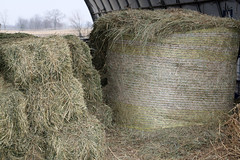It is getting increasingly expensive to feed sheep, goats, and other livestock. Even if you grow your own feed, there can be significant costs, including opportunity costs (selling the feed vs. feeding it). All producers should know how to compare feed costs and balance least-cost rations for their animals.
Feedstuffs are priced according to different units of measure: bushels, tons, pounds, or bales (of different sizes). Thus, the first step in comparing feed costs is converting prices to an equivalent unit, usually pounds.
Feed rations are balanced on an “as-fed” basis and feedstuffs are priced “as-is,” meaning that a portion of the weight of the feed is moisture (water). Because the dry matter content of feedstuffs varies tremendously, prices must be converted to a dry matter (DM) basis. To determine the dry matter cost of a feed, you divide the cost by the percent dry matter in the feed.
Feedstuffs also vary in the amount of protein, energy, and other nutrients that they contain. For this reason, the cost of providing a certain nutrient is the basis on which feedstuffs are compared. To determine the cost of a nutrient, you divide the dry matter feed cost by the percent nutrient in the feed.
You can use this Excel spreadsheet to compare the nutrient costs of different feedstuffs: http://www.sheepandgoat.com/spreadsheets/CompareNutrientCosts.xlsx.
Read full article
 |
| Which feed provides nutrients at the least cost? |
Feed rations are balanced on an “as-fed” basis and feedstuffs are priced “as-is,” meaning that a portion of the weight of the feed is moisture (water). Because the dry matter content of feedstuffs varies tremendously, prices must be converted to a dry matter (DM) basis. To determine the dry matter cost of a feed, you divide the cost by the percent dry matter in the feed.
Feedstuffs also vary in the amount of protein, energy, and other nutrients that they contain. For this reason, the cost of providing a certain nutrient is the basis on which feedstuffs are compared. To determine the cost of a nutrient, you divide the dry matter feed cost by the percent nutrient in the feed.
You can use this Excel spreadsheet to compare the nutrient costs of different feedstuffs: http://www.sheepandgoat.com/spreadsheets/CompareNutrientCosts.xlsx.
Read full article

2 comments:
im quite close friends with a farmer and he has mentioned the feeding costs of his animals for a while now. The cost are going up for pretty much everything for him and is making it questionable whether he still has a viable business.
Your comment is so true. Feed costs are getting so high and for some producers, they may have reach the point at which profitability is no longer possible. On the other hand, there are many ways to reduce feed costs.
Post a Comment